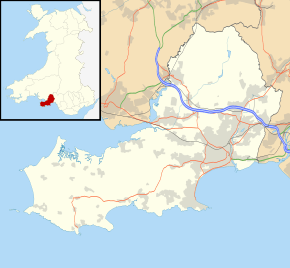Oystermouth
Oystermouth (a corruption of the Welsh name Ystum Llwynarth or Ystumllwynarth) is a village and electoral ward in the district of Mumbles, Swansea, Wales. It is part of the Mumbles community (civil parish).
| Oystermouth | |
|---|---|
 Shops in Oystermouth | |
 Oystermouth Location within Swansea | |
| Area | 2.01 km2 (0.78 sq mi) |
| Population | 4,160 (2011 census) |
| • Density | 2,070/km2 (5,400/sq mi) |
| Principal area | |
| Ceremonial county | |
| Country | Wales |
| Sovereign state | United Kingdom |
| Post town | SWANSEA |
| Postcode district | SA3 |
| Dialling code | 01792 |
| Police | South Wales |
| Fire | Mid and West Wales |
| Ambulance | Welsh |
| UK Parliament | |
| Senedd Cymru – Welsh Parliament |
|
| Councillors |
|
The electoral ward consists of some or all of the following areas: Oystermouth, the Mumbles, Thistleboon, Limeslade, in the parliamentary constituency of Gower. The ward is bounded by Newton to the west, West Cross to the north and Swansea Bay to the south and east. As of 2010 it had a population of around 4,100.[1]
Description


The ward consists of suburban housing stretching from the northwest to the southeast. It is surrounded by the sea to the east and south. Two hills at Rams Tor and Mumbles Hill have little development. Mumbles Hill is now a protected nature reserve managed by the local council. The boundaries of Mumbles community and the Oystermouth ward are clearly defined. However, in the public mind, the separation between villages of Oystermouth and Mumbles is not clear. Local buses to the area are signed as Oystermouth, although most people from the area would say they are living in Mumbles.
Local beaches include the southern tip of Swansea Bay, Bracelet Bay and Limeslade Bay. From the Mumbles Head area, there are views towards Swansea, Port Talbot, and the hills of the South Wales Coalfield.
Oystermouth is the site of Oystermouth Cemetery.
Oystermouth was served by the Swansea and Mumbles Railway, one of the very earliest passenger rail services, along a shoreline railway used in the 19th century to transport limestone and coal. The long-disused (since the 1960s) route remains as a cycle/footpath.
Oystermouth parish is part of the Church in Wales. It has two churches: All Saints' Church, Oystermouth, and Norton Mission Church.[2] All Saints' Church dates back as far as the 12th-century, with 19th-century additions and has a Grade II heritage listing.[3]
Rowan Williams took the title Baron Williams of Oystermouth upon his retirement as Archbishop of Canterbury in December 2012.[4]
Oystermouth Castle
The 12th-century Oystermouth Castle is well preserved, in grounds with views over Swansea Bay. It was rebuilt in stone by the de Braoses, who were Lords of the Gower, and visited briefly by King Edward I of England in 1284. By the 16th century the castle was abandoned and in ruins.[5]
Electoral ward
For the 2012 local council elections, electorate turnout was 37.23%. The election results were:
| Candidate | Party | Votes | Status |
|---|---|---|---|
| Anthony Colburn | Conservative | 500 | Conservative hold |
| Pam Erasmus | Labour | 444 | |
| Dorian Davies | Independent | 311 |
Tony Colburn was re-elected in May 2012 with a vote of 500, on a 37.2% turnout.
The ward has been represented continuously by the Conservative Party since 1995.[6]
See also
References
- "Oystermouth ward profile" (PDF). Swansea ward profiles. Archived from the original (PDF) on 5 September 2012. Retrieved 26 January 2013.
- "Oystermouth Parish".
- Church of All Saints, Oystermouth, Mumbles, British Listed Buildings. Retrieved 21 July 2018.
- "Peerage for the Lord Archbishop of Canterbury". Number 10.
- "Oystermouth Castle". Castles of Wales. Retrieved 21 July 2018.
- Swansea Welsh Unitary Council Election Results 1995-2012, The Elections Centre. Retrieved 21 July 2018.
External links
![]()
